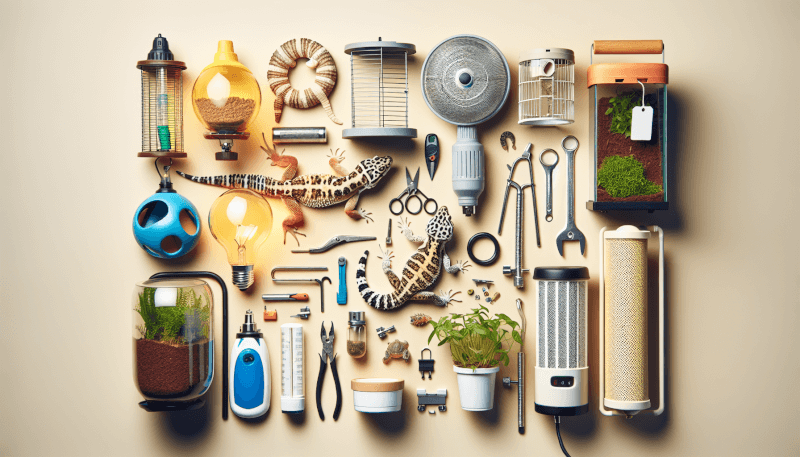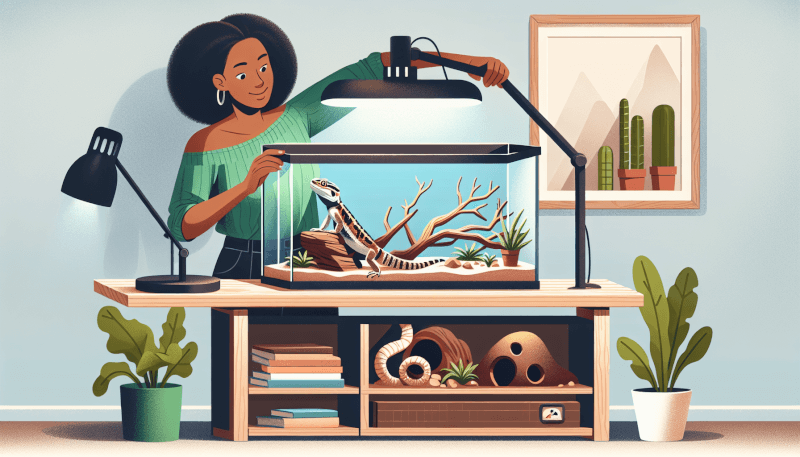Owning a pet reptile can be an incredibly rewarding experience, but ensuring their well-being requires the right accessories. In this article, discover a concise guide to the essential reptile accessories that every owner should have. From heating and lighting equipment to proper bedding and hiding spots, these must-have items will create a comfortable and stimulating environment for your scaly companion. Whether you’re a first-time reptile owner or looking to enhance your existing setup, these accessories are the key to providing the best care possible for your cold-blooded friend.

Habitat Essentials
Enclosure
The enclosure is the most important aspect of creating a suitable habitat for your reptile. It should provide ample space for them to move around comfortably, while also ensuring their safety. Choose a sturdy enclosure that is appropriate for the size of your reptile. For smaller species, a glass terrarium with a secure lid may be suitable, while larger reptiles may require custom-built enclosures made of PVC or other durable materials. Take into consideration the specific needs of your reptile when selecting an enclosure, such as the need for ventilation or humidity control.
Substrate
Choosing the right substrate for your reptile’s enclosure is crucial for their well-being. The substrate should mimic their natural environment and provide a comfortable area for them to rest and move around on. There are various options available, such as reptile carpet, paper towels, coconut fiber, or even sand in some cases. Research the specific requirements of your reptile species to determine the best substrate option for them.
Heating
Reptiles are ectothermic, which means they rely on external heat sources to regulate their body temperature. Providing a suitable heating source is essential for their overall health and well-being. Heat lamps, heat mats, or ceramic heat emitters can be used to create a warm area in the enclosure, while also providing a cooler area for the reptile to retreat to. Use a thermostat to regulate the temperature and ensure it remains within the appropriate range for your reptile species.
Lighting
Lighting plays a vital role in a reptile’s habitat. Not only does it provide illumination, but it also helps regulate their natural biological processes, such as metabolism and vitamin synthesis. Reptiles require both visible light and UVB radiation, which aids in the synthesis of vitamin D3. Use a combination of fluorescent or LED lights to provide the necessary lighting for your reptile. UVB bulbs should be replaced regularly, as they lose their effectiveness over time.
Thermometer and Hygrometer
Monitoring the temperature and humidity levels in your reptile’s enclosure is crucial for their health. Use a digital thermometer and hygrometer to ensure the habitat stays within the appropriate range for your reptile species. Place the thermometer and hygrometer in different areas of the enclosure to get an accurate reading of the overall conditions. Make any necessary adjustments to maintain the optimal temperature and humidity levels.
Hideouts
Creating hiding spots within the enclosure is essential for reptiles. These hideouts provide a sense of security and privacy for your reptile, allowing them to feel comfortable and stress-free. Use natural materials such as rocks, branches, or caves to create hiding spots in different areas of the enclosure. These hideouts should be easily accessible for your reptile and should be placed in both the warm and cool areas of the habitat.
Feeding Accessories
Food Bowl
Providing a designated food bowl for your reptile makes feeding time more organized and prevents food from spreading throughout the enclosure. Choose a shallow and durable bowl that is easy to clean. The size of the food bowl should be suitable for the size of your reptile, allowing them to access their food without difficulty.
Water Bowl
Reptiles require access to fresh water at all times. Provide a sturdy water bowl that is large enough for your reptile to soak in if necessary. The bowl should be shallow to prevent the reptile from drowning and should be cleaned and refilled regularly to ensure cleanliness.
Feeding Tweezers
Feeding tweezers are useful accessories for offering live or pre-killed insects to your reptile. They allow for precise feeding and reduce the risk of accidental bites or injuries. Use the feeding tweezers to hold the insects and gently offer them to your reptile, mimicking their natural hunting behavior.
UVB Supplements
In some cases, reptiles may require additional UVB supplementation to ensure they are receiving enough of this essential radiation. Consult with a reptile veterinarian to determine if your reptile needs UVB supplements and the appropriate dosage. Follow the veterinarian’s instructions carefully when administering the supplements.

Cleaning and Maintenance
Terrarium Cleaner
Regular cleaning of the enclosure is necessary to maintain a healthy environment for your reptile. Use a reptile-safe terrarium cleaner to clean the enclosure walls, substrate, and any decorative accessories. Avoid using harsh chemicals or cleaners that may be toxic to reptiles. Follow the manufacturer’s instructions when using a terrarium cleaner.
Water Conditioner
Water conditioners are essential for removing chlorine and other harmful chemicals from tap water. Reptiles are sensitive to impurities in water, and using a water conditioner ensures their drinking water is safe and free of contaminants. Add the appropriate amount of water conditioner to the water bowl when refilling it.
Reptile Safe Disinfectant
Occasionally, it may be necessary to disinfect the enclosure and accessories to prevent the spread of bacteria or parasites. Use a reptile-safe disinfectant specifically designed for use in reptile habitats. Follow the manufacturer’s instructions for dilution and application, and ensure the enclosure is thoroughly rinsed after disinfection.
Terrarium Substrate Scoop
A substrate scoop is a helpful tool for spot-cleaning the enclosure. Use the scoop to remove any soiled substrate or waste, keeping the enclosure clean and odor-free. Regular spot-cleaning helps maintain a hygienic environment for your reptile and prevents the buildup of bacteria or harmful germs.
Siphon
If you have an enclosure with a water feature, such as a swimming area or waterfall, a siphon can be a useful tool for cleaning and maintaining the water quality. Use the siphon to remove any debris or waste from the water, ensuring a clean and healthy environment for your reptile.
Humidity Control
Some reptile species require specific humidity levels to thrive. Investing in a humidity control system, such as a humidifier or fogger, can help regulate and maintain the appropriate humidity for your reptile’s needs. Monitor the humidity levels regularly using a hygrometer and adjust the control system as necessary.
Health and Wellness
Reptile Vet
Having a trusted reptile veterinarian is essential for ensuring the health and well-being of your reptile. Regular veterinary check-ups are recommended to monitor their overall condition and to address any potential health concerns. The veterinarian can provide guidance on nutrition, breeding, and general care for your reptile.
Thermometer and Hygrometer
A reliable thermometer and hygrometer are essential tools for monitoring the temperature and humidity levels in the enclosure. Regularly check these measurements to ensure they are within the appropriate range for your reptile species. Any sudden changes or deviations from the optimal ranges may indicate an issue that needs to be addressed.
Reptile First Aid Kit
Having a first aid kit specifically designed for reptiles is a wise investment for any reptile owner. It should contain essential items such as antiseptic solution, bandages, wound dressings, and other medical supplies. Familiarize yourself with the proper use of these items and consult with a reptile veterinarian for guidance on providing basic first aid for your reptile.
Calcium and Vitamin Supplements
Reptiles have specific dietary requirements, and providing them with the necessary calcium and vitamin supplements is crucial for their overall health. These supplements help prevent deficiencies and support proper bone growth and development. Consult with a reptile veterinarian to determine the appropriate dosage and frequency for your reptile species.
Reptile Safe Insecticides
In some cases, reptiles may be susceptible to parasites or external pests such as mites or ticks. Having a reptile-safe insecticide on hand can help control these pests and prevent infestations. However, it is essential to follow the manufacturer’s instructions carefully and consult with a reptile veterinarian before using any insecticides on your reptile or in their enclosure.

Handling and Interaction
Reptile Handling Gloves
If you have a larger reptile or a species with a tendency to bite or scratch, reptile handling gloves can provide an extra layer of protection during handling sessions. These gloves are made from sturdy materials that can withstand bites and scratches, keeping your hands safe.
Reptile Tongs
Reptile tongs are useful tools for safely handling and feeding your reptile, especially if they have a tendency to strike at food or lunge unexpectedly. Used properly, reptile tongs provide a safe distance between you and your reptile during interaction, reducing the risk of accidental bites or injuries.
Reptile Leashes
Some reptile species can be leash-trained, allowing you to take them outside for supervised exploration. Reptile leashes are specially designed to be secure and comfortable for your reptile, allowing them to enjoy the outdoors while ensuring their safety. When using a reptile leash, always supervise your reptile closely and never leave them unattended.
Decorative Accessories
Backgrounds
Decorative backgrounds can add aesthetic appeal to your reptile’s enclosure. Choose backgrounds that mimic their natural habitat or create a visually appealing backdrop. These backgrounds can be easily attached to the enclosure walls, transforming the habitat into a visually stunning display.
Artificial Plants
Artificial plants are a great way to add greenery and a natural feel to the enclosure without the maintenance that comes with live plants. Choose reptile-safe artificial plants that are easy to clean and do not contain any toxic materials. These plants provide hiding spots and climbing opportunities for your reptile, enhancing their habitat.
Rock Formations
Rock formations can serve both functional and aesthetic purposes in your reptile’s enclosure. They provide additional climbing surfaces, basking spots, and hiding places for your reptile. Choose rocks that are smooth and securely anchored in the enclosure to prevent any accidents or injuries.
Logs and Branches
Logs and branches can be used to create a natural and stimulating environment for your reptile. They provide climbing opportunities and create an interesting landscape within the enclosure. Ensure the logs and branches are securely placed to prevent any collapses or injuries.
Caves and Hiding Spots
Caves and hiding spots are crucial for reptiles to feel secure and reduce stress. These accessories provide a safe space for your reptile to retreat to when they want to hide or rest. Choose caves or hiding spots that are appropriate for the size of your reptile and easily accessible for them.

Transportation and Travel
Reptile Terrarium Carrier
When traveling with your reptile, a reptile terrarium carrier is an essential accessory. These carriers are specifically designed to provide a safe and secure environment for your reptile during transportation. They often have secure locks and ventilation systems to ensure the well-being of your reptile.
Heat Packs
If you’re traveling to a colder climate or need to maintain a specific temperature during transportation, heat packs can help provide the necessary warmth for your reptile. These packs are activated by air and can provide heat for several hours. Place them strategically in the carrier to ensure your reptile stays warm during the journey.
Water Containers
During longer journeys, it is essential to provide water for your reptile to stay hydrated. Use water containers specifically designed for reptiles and ensure they are securely attached to the carrier to prevent spills. Regularly check and refill the water container as needed.
Breeding and Incubation
Reptile Breeding Racks
If you’re a reptile breeder, investing in reptile breeding racks can greatly assist in the breeding process. These racks provide separate compartments for each breeding pair or individual, allowing for controlled breeding and easy monitoring of the eggs or young reptiles.
Incubators
Incubators are essential for reptile breeders who want to take a more hands-on approach to breeding. They provide a controlled environment for eggs to develop and hatch successfully. Ensure the incubator maintains a consistent temperature and humidity level that matches the requirements of your reptile species.
Egg Containers
Once the eggs are laid, it is important to provide a safe and suitable environment for their incubation. Egg containers specifically designed for reptiles can provide the necessary protection and support for the developing eggs. These containers should be clean, sterilized, and well-ventilated to ensure the eggs receive the proper oxygen supply.
Automatic Egg Turner
In some cases, especially for reptiles that lay large clutches of eggs, manually turning the eggs can be time-consuming and prone to error. An automatic egg turner provides a gentle and consistent rotation of the eggs, ensuring optimal development and preventing complications that may arise from improper turning.

Environmental Enrichment
Climbing Structures
Reptiles are natural climbers, and providing climbing structures within their enclosure allows them to engage in their natural behavior. Use sturdy branches or specialized climbing structures to create a vertical space for your reptile to explore and climb. Ensure these structures are securely anchored to prevent any accidents.
Swimming Area
If you have a semi-aquatic or aquatic reptile, providing a swimming area is essential for their well-being. This area should have a suitable depth and size to accommodate the reptile’s swimming needs. Ensure the water is clean and regularly maintained to prevent any health issues.
Basking Platforms
Basking platforms provide a warm and elevated area for your reptile to bask and soak up heat. Use natural materials such as rocks or logs to create a comfortable and stable platform for your reptile. The platform should be positioned close to the heat source to provide the necessary warmth.
Toys and Puzzle Feeders
Environmental enrichment is important to keep your reptile stimulated and mentally engaged. Toys and puzzle feeders can be used to provide enrichment, encouraging natural behaviors such as hunting or foraging. Choose reptile-safe toys and puzzle feeders that are appropriate for the size and activity level of your reptile.
Educational Resources
Reptile Care Books
Educating yourself about your reptile’s specific care requirements is essential for providing them with the best possible care. Reptile care books provide detailed information about habitat setup, feeding, handling, and overall care for various reptile species. Invest in reputable care books that are specific to your reptile species to ensure accurate and reliable information.
Online Forums and Communities
Online forums and communities dedicated to reptile care can be valuable resources for information and support. These platforms allow reptile owners to connect, share experiences, and seek advice from experienced reptile enthusiasts. Participating in these forums can provide valuable insights and help keep you updated on the latest reptile care practices.
Training and Handling Guides
Handling and training your reptile can be a rewarding experience for both you and your pet. Training and handling guides provide step-by-step instructions on how to safely and effectively handle and train your reptile. These guides can provide useful tips and techniques to build trust and strengthen the bond between you and your reptile.
In conclusion, providing the right accessories for your reptile’s habitat is essential for their health and well-being. From the enclosure and substrate to feeding accessories and environmental enrichment, each aspect contributes to creating a suitable and stimulating environment for your reptile. Remember to always research your specific reptile species’ needs and consult with a reptile veterinarian for guidance on proper care. With the right accessories and care, you can provide your reptile with a comfortable and enriching life.


